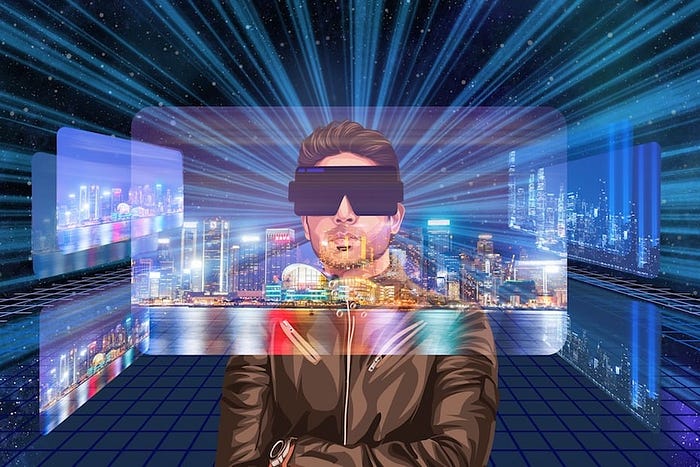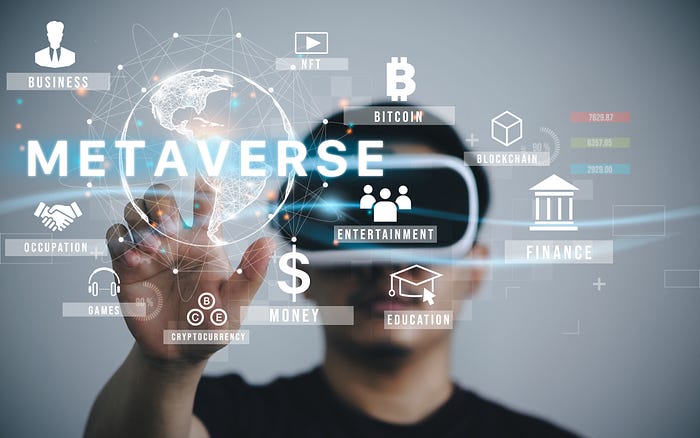

The Best Courses to Help UX Designers Explore Metaverse technologies
source link: https://uxplanet.org/the-best-courses-to-help-ux-designers-explore-metaverse-technologies-47e812f82078
Go to the source link to view the article. You can view the picture content, updated content and better typesetting reading experience. If the link is broken, please click the button below to view the snapshot at that time.
The Best Courses to Help UX Designers Explore Metaverse technologies
… and develop useful skills

Source:
According to Google, the number of queries with the word “metaverse” has increased by 14043% in a year. And renaming Facebook into Meta, and wanting to turn it into a meta-universe company in 5 years, already indicates that the metaverse is becoming a trend.
So what is a Metaverse?
Source: seekingalpha.com
A metaverse is a virtual space which exists in real-time. In it, users interact with each other and digital objects through personal avatars with the help of virtual reality technologies. The natural world’s cultural, social, economic and political laws are not necessary for the meta-virtual universe.
In the metaverse, a person’s status may be determined more by the degree of development of their avatar. According to Mark Zuckerberg, in the metaverse, people will do what they do in the real world.
How is the metaverse different from the Internet and online games?
Matthew Ball, a modern technology ideologue, cited the following features of the metaverse:

Source: amazon.com
- It exists forever. It cannot be stopped, restarted or deleted.
- It exists live. New events can be created.
- Those who wish can join it, regardless of the number and at any given time.
- It has its economy. Users and businesses can get money for a particular activity and then spend or invest it.
- Combines physical and digital worlds, open and closed platforms, and private and public networks.
- It contains the “content and experiences” that its “inhabitants”, avatars, have created.
Examples of metaverses
Source: unsplash.com
Many companies strive to develop the best virtual spaces as quickly as possible. The closest to this is the following examples.
Microsoft Mesh in the Azure cloud
In this world, users can interact with each other using virtual avatars in different locations. It can be connected using a VR headset, smartphone, PC and Microsoft’s HoloLens 2 AR headset.
So far, it’s more about collaborative workspace, about “holoporting” in the work environment to increase decision-making flexibility.
Nvidia Corp.
Nvidia has a concept similar to the one presented at Microsoft. The company wants to make a shared workspace between creators of 3D objects from different fields. And the metaverse will allow developers to model other things.
Epic Games
Epic Games has raised $1 billion in investment to create a metaverse. Tim Sweeney, co-founder and head of Epic Games, sees a virtual world as a fully open standard that could replace the Internet.
The company believes that the metaverse is the next evolution of social networks and promises a three-dimensional space where people can interact, communicate, learn and play in ways that weren’t previously possible.
What is needed for the metaverse to exist?

Source: gulfbusiness.com
The metaverse needs a reliable infrastructure for its stable existence. After all, a metaverse is impossible without computation, data preservation, machine learning, and piecewise intelligence. They are all inseparable from cloud technology.
In addition to the cloud, there are several other components of the metaverse infrastructure:
- The hardware platform (VR/AR devices, gadgets, PCs and other devices).
- A network with high bandwidth and data transfer rates.
- Calculations and robust systems for working with artificial intelligence, processing vast amounts of information, rendering and games.
- Tools for continuous development, copyright support, data transfer, and AI technology.
- Payments enable people and businesses to make financial transactions.
- Content and services.
- User behaviour as it affects the principles and philosophy of the universe.
6 TOP courses to develop skills and learn about metaverse technologies

Source: cio.com
If you want to build a career in the metaverse and contribute to a virtual world that mimics the real-life experience, it’s time to take the actual courses.
1. Web3 Blockchain Bootcamp
The metaverse has everything to do with cryptocurrencies. After all, in a world where you can be anyone and build businesses and use services, you will also need finance and digital currency.
On the other hand, cryptocurrency relies on blockchain technology, in many ways similar to the metaverse. This suggests that it is worth getting a fundamental knowledge of blockchain development at Polygon.
You need to have a basic knowledge of JavaScript to learn.
The course will teach you the following:
- Blockchain and Cryptography Fundamentals.
- Blockchain Accounts and Data Structures.
- Learning Ethereum & Ethereum Ecosystem.
- Smart Contract Basics.
- dApps: inheritance, solidity tokens, decentralised file storage, layer two scaling, rollups and skills honing.
- Mastering Solidity (events, RNG and security).
2. Virtual Reality Specialization — Coursera
Developing skills in virtual reality is crucial for the development of the metaverse.
In this online course, you will understand virtual reality and its components. You will learn how to develop virtual reality applications. You will work on various projects and learn the basics of interactive design and 3D computer graphics at the same time.
3. The Complete Unity Game Development Course — Udemy
This course will give you the knowledge, skills and tools to develop cool metaverse games using the Unity engine.
First, you will learn the Unity Game Engine features and how to use them. You’ll try to create character animations and program the behaviour of non-playable characters using artificial intelligence. You will learn how to add dynamic visual and sound effects to make the world more realistic and how to enhance the virtual environment with lighting. After the course, you will understand how to create a game project with Unity.
Over 5,000 students have completed the course, and 700+ have left good feedback.
4. SuperHi Intro to User Experience Design
This course teaches you how to create interface designs that provide the best user immersion in a virtual environment. Since the training is designed for beginners, you only need to be computer literate.
I recommend this course to those who want to learn the basics of UX/UI design, as the topics overlap. Notably, the differences between UI, graphic, and UX design are highlighted here.
Overall, in the course, you will learn the following:
- The difference between UX design and graphic design
- The processes of UX design
- How to create personas, user paths, sitemaps and user flows
- How to create prototypes
- How to create an effective UX design
The benefits of the course are real projects, quality resource materials and access to the UX design community.
5. Augmented Reality & Virtual Reality Metaverse Business — Udemy
Augmented Reality and Virtual Reality are the technologies that underpin the metaverse. Hence, understanding how they are set up, what tools and technologies work there, how effective they are, and what business opportunities emerge from the metaverse are all vital information for those who want to succeed in the metaverse.
What the course consists of:
- An introduction to virtual reality (VR) and augmented reality (AR).
- Vendors, tools and software.
- Virtual and augmented reality applications.
- Business ideas for AR applications and guidelines for selling freelance services in AR and VR.
6. Metaverse Masterclass — Udemy
The course covers elements of the technical infrastructure of the metaverse, including blockchain, NFT and cryptocurrencies and how to invest in them, virtual and augmented reality and how to buy and sell land in the metaverse.
It’s very short (3.5 hours) but capacious. It will be a good starting point for you.
If you know of any good courses that would complement this selection, please share them with me.
Recommend
About Joyk
Aggregate valuable and interesting links.
Joyk means Joy of geeK